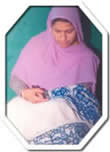|
|
Perhaps the most celebrated of traditional Kashmiri handicrafts is embroidery. Whether the flowing designs grace shawls, wall hangings, namdhas or tunics, Kashmiris are known as master embroidery artisans. The fabric is a canvas through which the artisan's embroidery brings to life designs that may have been handed down for centuries. The Kashmiri embroidery artisan uses their needle as a painter uses a brush, the fabric is their canvas for which they create their masterpieces.
There are four main types of embroidery that have developed in Kashmir. Each has its own special quality and distinct style

The first is needlework (sozni) which is generally used along the borders of shawls. Motifs, usually abstract designs or stylized paisleys and flowers are worked in one or two, and occasionally three subdued colors. The patterns seem to flow across the shawls, imparting a quiet yet majestic beauty. The stitch employed is not unlike a stem stitch. The delicacy of workmanship and the amount of embroidery determines the value of the shawl. Needlework is often done so skillfully that the motif appears on both sides of the shawl, each side having a different color scheme and no trace of the stitch.
|
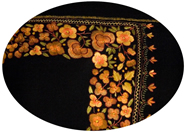 |
Click to enlarge |
|
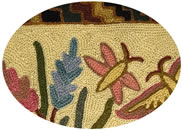 |
Click to enlarge |
|

The second type of embroidery is chain stitch. Be it with wool, silk or cotton thread, it is done by a hook, referred to as aari, rather than a needle. The intrinsic worth of each piece lies in the sizes of the stitches and the yarn used. Tiny stitches are used to cover the entire area of the item, unlike needlework which only covers a small part. The figures or motifs are worked in striking colors; the background is in a single color, made up of a series of coin sized concentric circles which impart dynamism and a sense of movement to the design. Stitches ought to be small, even sized, and neat. The background fabric should not be visible through the stitches. Items that are beautified with the elegant chain stitch designs include wall hanging and pillow covers.
|

The third type of embroidery is crewel work, which is a type of chain stitch generally done on white background. A key characteristic of crewel work is the motifs do not cover the entire surface, and the background is not embroidered upon. Crewel is done on thick material popularly used for furnishings and usually carries flowing floral and climbing designs. Crewel embroidery is done in thick wool yarn which provides a very dazzling and durable material for drapes and upholstery. Embroidery is hand done in either single or double ply wool. Items such as namdhas, purses and linens have crewel work designs. Crewel work with lighter yarn, even silk, is also used for shawls designs.
|
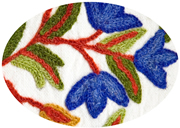 |
Click to enlarge |
|
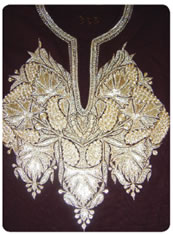 |
Click to enlarge |
|

Finally, tilla dozi is gold or silvery thread embroidery which is placed on women's garments traditionally used at the time of weddings. The pattern covers the breast and might also appear are the cuffs. Although not as common, tilla dozi can also be found on shawls.
|
Regardless of the type of stitch, there are four main factors that influence the value of an embroidered item:
- The quality of the material to be embroidered upon. For example, a true Pashmina shawl costs more than a regular wool based shawl.
- The quality of the yarn/thread being used, which will dictate how strong the yarn is, its color-fastness etc.
- The artistic quality of the pattern/design itself.
- The finesse and expertise of the artist in embroidering the design onto the piece.
Kashmiris are true master embroidery artists, and true Kashmiri masterpieces are a intersection of all the above factors.
|






